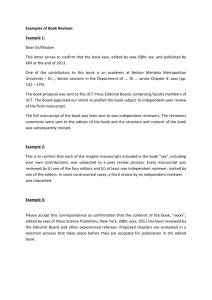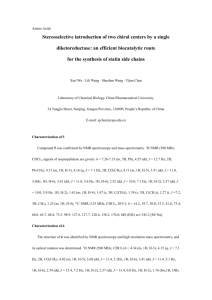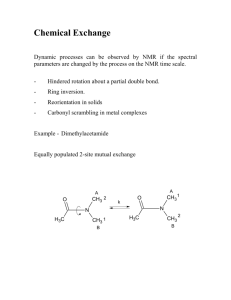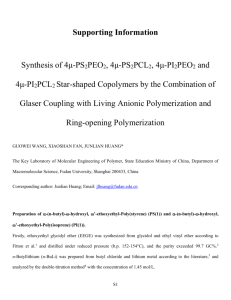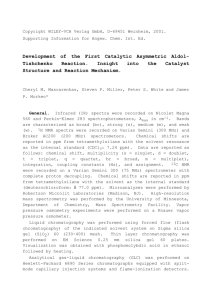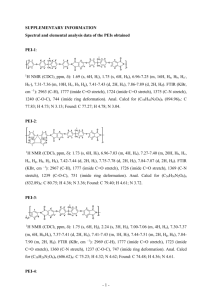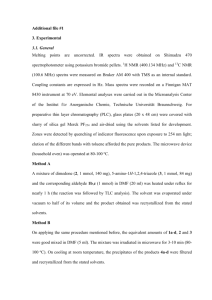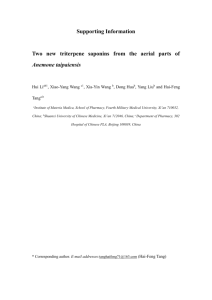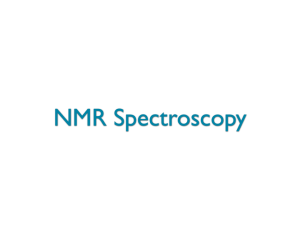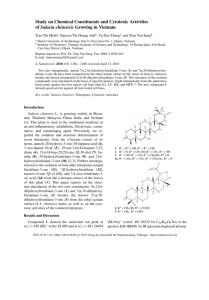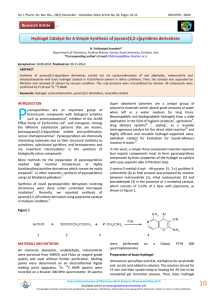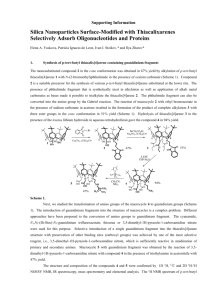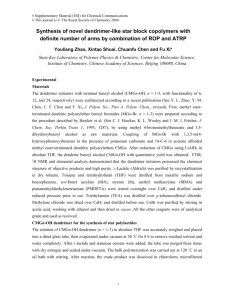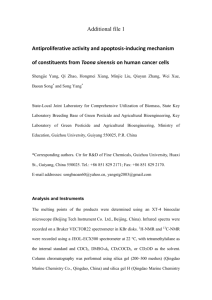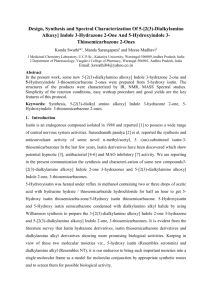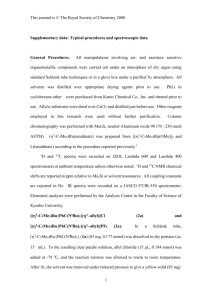(Past) Volume 3 - Indian Journal of Advances in Chemical Science
advertisement
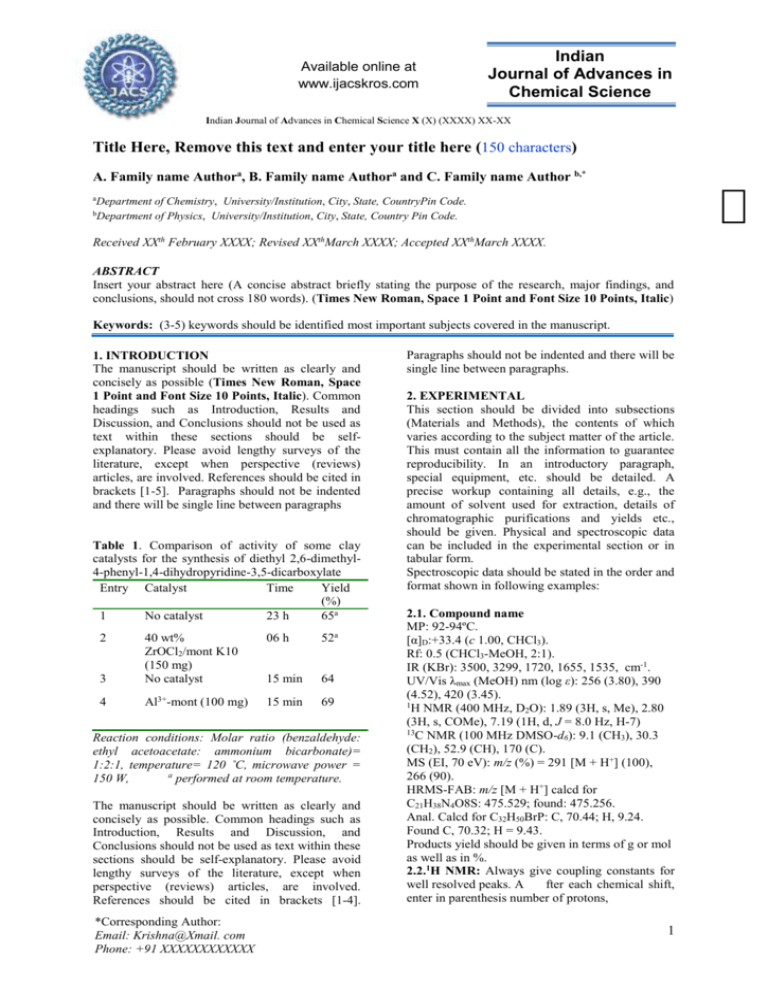
Available online at www.ijacskros.com Indian Journal of Advances in Chemical Science Indian Journal of Advances in Chemical Science X (X) (XXXX) XX-XX Title Here, Remove this text and enter your title here (150 characters) A. Family name Authora, B. Family name Authora and C. Family name Author b,* aDepartment bDepartment of Chemistry, University/Institution, City, State, CountryPin Code. of Physics, University/Institution, City, State, Country Pin Code. Received XXth February XXXX; Revised XXthMarch XXXX; Accepted XXthMarch XXXX. ABSTRACT Insert your abstract here (A concise abstract briefly stating the purpose of the research, major findings, and conclusions, should not cross 180 words). (Times New Roman, Space 1 Point and Font Size 10 Points, Italic) Keywords: (3-5) keywords should be identified most important subjects covered in the manuscript. 1. INTRODUCTION The manuscript should be written as clearly and concisely as possible (Times New Roman, Space 1 Point and Font Size 10 Points, Italic). Common headings such as Introduction, Results and Discussion, and Conclusions should not be used as text within these sections should be selfexplanatory. Please avoid lengthy surveys of the literature, except when perspective (reviews) articles, are involved. References should be cited in brackets [1-5]. Paragraphs should not be indented and there will be single line between paragraphs Table 1. Comparison of activity of some clay catalysts for the synthesis of diethyl 2,6-dimethyl4-phenyl-1,4-dihydropyridine-3,5-dicarboxylate Entry Catalyst Time Yield (%) 1 No catalyst 23 h 65a 06 h 52a 3 40 wt% ZrOCl2/mont K10 (150 mg) No catalyst 15 min 64 4 Al3+-mont (100 mg) 15 min 69 2 Reaction conditions: Molar ratio (benzaldehyde: ethyl acetoacetate: ammonium bicarbonate)= 1:2:1, temperature= 120 ˚C, microwave power = a 150 W, performed at room temperature. The manuscript should be written as clearly and concisely as possible. Common headings such as Introduction, Results and Discussion, and Conclusions should not be used as text within these sections should be self-explanatory. Please avoid lengthy surveys of the literature, except when perspective (reviews) articles, are involved. References should be cited in brackets [1-4]. *Corresponding Author: Email: Krishna@Xmail. com Phone: +91 XXXXXXXXXXXX Paragraphs should not be indented and there will be single line between paragraphs. 2. EXPERIMENTAL This section should be divided into subsections (Materials and Methods), the contents of which varies according to the subject matter of the article. This must contain all the information to guarantee reproducibility. In an introductory paragraph, special equipment, etc. should be detailed. A precise workup containing all details, e.g., the amount of solvent used for extraction, details of chromatographic purifications and yields etc., should be given. Physical and spectroscopic data can be included in the experimental section or in tabular form. Spectroscopic data should be stated in the order and format shown in following examples: 2.1. Compound name MP: 92-94ºC. [α]D:+33.4 (c 1.00, CHCl3). Rf: 0.5 (CHCl3-MeOH, 2:1). IR (KBr): 3500, 3299, 1720, 1655, 1535, cm-1. UV/Vis λmax (MeOH) nm (log ε): 256 (3.80), 390 (4.52), 420 (3.45). 1 H NMR (400 MHz, D2O): 1.89 (3H, s, Me), 2.80 (3H, s, COMe), 7.19 (1H, d, J = 8.0 Hz, H-7) 13 C NMR (100 MHz DMSO-d6): 9.1 (CH3), 30.3 (CH2), 52.9 (CH), 170 (C). MS (EI, 70 eV): m/z (%) = 291 [M + H+] (100), 266 (90). HRMS-FAB: m/z [M + H+] calcd for C21H38N4O8S: 475.529; found: 475.256. Anal. Calcd for C32H50BrP: C, 70.44; H, 9.24. Found C, 70.32; H = 9.43. Products yield should be given in terms of g or mol as well as in %. 2.2.1H NMR: Always give coupling constants for well resolved peaks. A fter each chemical shift, enter in parenthesis number of protons, 1 . Insert Diagram/Scheme/Flow chart CH3 N CH3 N C C pH= 5.47 N N H C N pK1 NH2 N C NH2 XH Enol form X Keto form pH=8.56 pK2 CH3 X= S,O N APT-pH = 5.47(pK1);pH = 8.56(pK2) APS -pH= 6.16(pK1);pH = 8.30(pK2) C N N C NH2 X Mono anion Figure 1: Please use this paragraph to type the legend(s) for your scheme(s) or figure(s), as well as the heading 1.Different species of APT and APS in solution at different pH values for aScheme table and the table footer(s). multiplicity, coupling constants, and assignment in that order. should be brief and placed after the experimental section. 2.3. 13C NMR: Carbon-13 NMR data should be reported to the nearest 0.1 ppm with the number of attached hydrogens designated as CH3, CH2, CH and C notion. 5. REFERENCES Please insert your references here. For one reference number contains more than one citation please separate them into (a), (b), (c), (d) etc. Some examples of references are given below. For further information on how the references should be written please see the instructions for authors: 2.4. Crystallographic Data: Complete X-ray data will not be published. They should be deposited at an appropriate international data institute, which is then cited in a reference. If a representation of the crystal structure (e.g., ORTEP) is to be included, it should be accompanied by the following data:(1) formula, (2) crystal data, (3) method of collection, (4) methods of structure solution and refinement, and (5) selected bond lengths and angles. 2.6. Supplementary data: IJACS accepts electronic supplementary material to support and enhance scientific research. Therefore, spectral data of all compounds may be included on separate sheets at the end of the manuscript which will be published online The presence of these files will be signified by a footnote to the article title, and by a description included in a "Supplementary data" section at the end of the paper. 3. RESULTS AND DISCUSSION 4. CONCLUSION Acknowledgments - The inclusion of an acknowledgements section is optional. It may include credit to technical assistance, financial support and other appropriate recognition, and [1]. P. Ghosh, G. Han, M. De, C. K. Kim, (2008) Gold nanoparticles in delivery applications, Advanced Drug Delivery Reviews, 60: 13071315. [2]. D. Pissuwan, T. Niidome, M.B. Cortie, (2009) The forthcoming applications of gold nanoparticles in drug and gene delivery systems,Journal of Controlled Release, 149: 65-71. [3]. G. Southam, T.J. Beveridge, (2006) Nitrate reductase- mediated synthesis of silver nanoparticles from AgNO3,Geochimcaet Cosmochimica Acta, 60: 4369-4376. [4]. R. Guo, Y. Song, G. Wang, R.W. Murray, (2005) Does core size matter in the kinetics of ligand exchanges of monolayer-protected Au clusters? Journal of American chemical society, 127: 2752-2757. [5]. S.B.M. Kanth, K. Kalishwaralal, M. Sriram, Suresh babu, P. Ram kumar, H.Youn, S. Eom, S. Gurunathan, (2010) Anti-oxidant effect of gold nanoparticles restrains hyperglycemic conditions in diabetic mice, Journal of nanobiotechnology, 8: 1-16. 2 *Bibliographical Sketch Incert recent pass port size photo Write here around 150 words of brief bibliographical sketch of Corresponding author only 3




